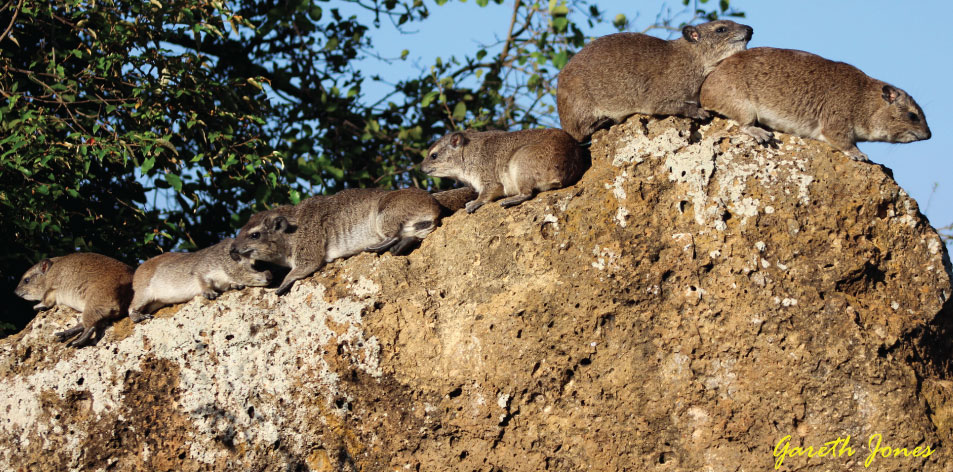
Highlighting Hyrax!!!- Article by Gareth Jones
Highlighting Hyrax In The Nairobi National Park
Very early one morning we drove down the western boundary, it was a clear, crisp morning and everything seemed new and fresh.
After a while, we drove up the steep slope that leads to the Mokoiyet picnic site. Immediately on our right, there was a sudden movement in the sunlight. There up on the highest rock sat a large family of yellow-spotted rock hyrax or bush hyrax (Heterohyrax brucei) sitting there, sunning themselves in the morning warmth. (Also known as Rock Rabbits (but they are not related to rabbits) or Pimbi in kiswahili or in some parts of Africa they are called Dassies).
Hyraxes (from Ancient Greek translates to meaning “shrew mouse”), also called dassies, are small, thickset, herbivorous mammals in the order Hyracoidea. Hyraxes are well-furred, rotund animals with short tails. Typically, they measure between 30 and 70 cm long and weigh between 2 and 5 kg. Scientifically, Hyrax are more closely related to elephants and sea cows. Hyraxes have a life span from 9 to 14 years.
Five different subspecies are scientifically recognised: the rock hyrax (Procavia capensis) and the yellow-spotted rock hyrax (Heterohyrax brucei), which both live on rock outcrops, including cliffs in Ethiopia and isolated granite outcrops called koppies in Southern Africa, the western tree hyrax (Dendrohyrax dorsalis), southern tree hyrax (D. arboreus), and eastern tree hyrax (D. validus). Their distribution is limited to Africa, except for the rock hyrax (P. capensis) which is also found in the Middle East.
The name-giving feature of the yellow-spotted rock hyrax, is a dorsal gland located on the lower back beneath a raised skin patch about 1.5 cm long and surrounded by erectile hairs. However, not all Heterohyrax species have a dorsal gland. The secretions of the gland stain a dorsal spot of reddish- ochre to a dirty white colouration, but most commonly appears yellow. The gland is associated with sexual arousal and also plays a role in maternal recognition by young. The bush hyrax is also noted to have a white patch of hair above the eyes, where glandular tissue also occurs. Glandular tissue also occurs under the chin and in the genital area.
Yellow spotted rock or bush hyrax are not to be confused with the species of eastern tree hyrax (Dendrohyrax validus) that are predominantly found in forested areas of the Nairobi National Park, the eastern tree hyrax has a distinct territorial call, it starts with a series of loud, measured cracking sounds, sometimes compared to “a huge gate with rusted hinges being forced open”. This is then followed by a series of seemingly “unearthly screams”, ending in a descending series of expiring, fading shrieks.
Rock Hyrax thrive in social groups of up to sixty individuals, and are very agile in rocky areas. They eat certain grasses and leaves, and are also known to eat insects. Hyraxes are often mistaken for being rodents, however, they are not related, and in fact, scientists believe they are even distantly related to elephants! Wow!!… that seems a bit weird, doesn’t it? Hyrax are so unlike other animals that they are placed in a separate order Hyracoidea. While they are said to be the elephant’s nearest living relative, this is true to a certain extent, but misleading since the relationship stems from a remote ancestor common to hyraxes, sea cows (dugongs and manatees) and elephants. These three are unlike other mammals, but they share various of disproportionate physiological similarities in teeth, leg and foot bones, testes (that do not descend into a scrotum) and other more obscure details.
Hyraxes have poorly developed internal temperature regulation, for which they compensate by active thermoregulation, such as huddling together and basking in the sun. Unlike most other browsing and grazing animals, they do not use the incisors at the front of the jaw for slicing off leaves and grass; rather, they use the molar teeth at the side of the jaw. The two upper incisors are large and tusk-like, and grow continuously through life, similar to those of rodents.
Although not ruminants, hyraxes have complex, multi-chambered stomachs that allow symbiotic bacteria to break down tough plant materials, but their overall ability to digest fibre is lower than that of the ungulates. Their mandibular motions are similar to chewing cud, but the hyrax is physically incapable of regurgitation as in the even-toed ungulates and the merycism of some of the macropods. This behaviour is referred to in a passage in the Bible which describes hyraxes as “chewing the cud”. This chewing behaviour may be a form of stress relief behaviour when the animal feels threatened. Their feet have rubbery pads with numerous sweat glands, which may help the animal maintain its grip when quickly moving up steep, rocky surfaces. Hyraxes have stumpy toes with hoof-like nails; four toes are on each front foot and three are on each back foot. They also have efficient kidneys, retaining water so that they can better survive in arid environments.
Female hyraxes give birth to up to four young after a gestation period of 7–8 months, depending on the species. Hyraxes live in small family groups, with a single male that aggressively defends the territory from rivals. Where living space is abundant, the male may have sole access to multiple groups of females, each with their own range. The remaining males live solitary lives, often on the periphery of areas controlled by larger males, and mate only with younger females.
The Hyraxes at the Mokoiyet picnic site sometimes allow persons to approach quite close to them, especially if the people move slowly and quietly stand still. We stood and watched them on the rocks for some time, with the beauty of the scenery visible below. And eventually drove away, leaving the rock hyrax’s sitting high above the valley, enjoying the sunlight. The Nairobi National Park has many fascinating and interesting creatures, and the Hyrax is one of them.


